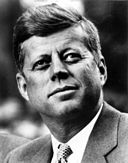By David Hiltbrand
The assassination of President John F. Kennedy was a watershed event for television as much as it was for the nation, providing the medium with an epiphany of its potential.
“This was a coming of age for TV,” said Ron Simon, curator at New York’s Paley Center for Media. “It was the gold standard for what TV could do.”
“I remember exactly where I was; I remember exactly what I was doing,” said Leonard Shyles, a communications professor at Villanova University who was a 10th grader at the time.
“From a media perspective, it was a critical event,” Shyles said. “Like a magnet pulling iron fibers, it arranged the American public around the TV. We were glued to the TV for four days of wall-to-wall coverage.”
In 1963, the three broadcast networks packaged the news in short, formal bursts. But the enormity of the president’s death forced them to reinvent their approach on the fly.
Though it represented a huge step forward for TV news, the images from that long, tragic weekend seem primitive in today’s environment of satellites and social media.
CBS was the first to report the shooting in Dallas on Nov. 22, breaking into “As the World Turns” at 1:40 p.m. Eastern time. But it was just the voice of Walter Cronkite speaking over a generic “News Bulletin” graphic, because a camera could not be located for the anchor on short notice.
On the air an hour later, Cronkite would provide one of television’s most enduring and moving tableaux, as he removed his glasses and fought back tears to confirm reports of the president’s death.
“The irony is, at that point, Cronkite was No. 2 to NBC,” Simon said. “Huntley and Brinkley were the dominant team. The images of Cronkite have become famous, but that was not the actual channel of choice for most Americans.”
All the networks suspended regular programming and commercials for the next four days, forfeiting $40 million in revenue.
Since JFK’s Texas tour was not considered consequential enough for coverage, there was no footage of the fateful moments on Dealey Plaza.
On Saturday, Nov. 23, CBS’s Dallas bureau chief, Dan Rather, was in negotiations to purchase the film shot by Abraham Zapruder, a Dallas resident who saw the assassination, but lost out to Life magazine. He then hurried on air to provide a verbal description of the contents. (It would be more than a decade before Zapruder’s footage would turn up on television.)
NFL commissioner Pete Rozelle decreed that the games would go on that Sunday, although CBS declined to broadcast them. The Eagles would beat the visiting Redskins, 13-10, at Franklin Field in a battle of the Eastern Division basement-dwellers. (After the season, in a gesture of futility, the teams would swap quarterbacks, with Sonny Jurgensen going to Washington for Norm Snead.)
Only NBC assigned a correspondent to cover the routine transfer of Lee Harvey Oswald to another jail that afternoon and thus had live footage of Oswald being shot by Jack Ruby, an event that was shocking in part because its immediacy was so foreign to viewers of that era.
The other networks then repeatedly showed the sequence, with CBS adding the wrinkle of slow motion, a technique that would create a sensation when it officially debuted two weeks later during the Army-Navy Game in Philadelphia.
The funeral ceremonies on Monday were watched on television by an astounding and never equaled 93 percent of Americans.
“Everything was in black and white, which added to the somber tone,” said Richard Goedkoop, a retired communications professor at La Salle University, who was 17 at the time. “One remembers the processional down Pennsylvania Avenue with Jack’s brothers and Jackie walking behind the caisson. And John-John saluting, which was unbelievably heartbreaking.”
“Television was able to summon the grace and dignity that was needed that Monday,” said Simon. “It allowed viewers to participate in the process. The eyewitness-to-history aspect of television was never so apparent as in those four days.”
The president’s widow insisted on the Eternal Flame at the grave site in Arlington National Cemetery because JFK had been so moved by the Flame of Eternal Peace at Gettysburg when they had visited the battlefield that Easter. (The monument at Gettysburg was redubbed the Eternal Light Peace Memorial when the park converted it to electricity in 1979.)
During that long, unimaginable interlude in November 1963, TV provided a communal experience for a shaken nation. “It was being used as an electronic church, a grieving mechanism for the country,” Goedkoop said. “I think that’s one of the key moments in television history.”
Never again would the world seem so big or our countrymen so close.



